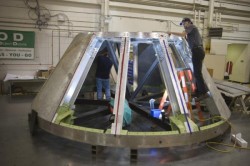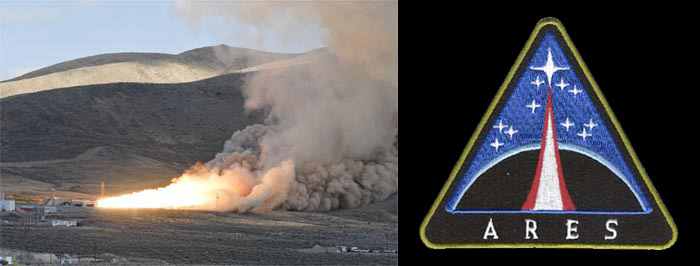[/caption]Despite being the subject of some bad news of late, development of the Ares rocket system and Orion crew module pushes ahead. In the Utah Desert on Thursday, the oldest ever Shuttle engine was tested. The seven-year old rocket (two years past its “guarantee”) performed a 123 second burn, simulating how long it would be in use during an optimal Shuttle launch. You may be asking, what does this have to do with Ares? Data from the Shuttle engine tests will be applied to the design of the Ares 1 rocket system, aiding engine nozzle design and boosting the robustness of the future Constellation Project. Environmental change measurements caused by pressure and sound during the firing will also be assessed.
While the Utah Desert rumbles with the sound of rockets, over at NASA’s Langley Research Center, in Hampton, Virginia, the Orion crew module and tower-like launch abort system simulators are rapidly being constructed toward the goal of full-scale Ares I-X atmospheric tests in 2009…

These are significant tests for NASA, as the space agency certifies the use of the reusable shuttle solid rocket engines for five years past the date of manufacture. This most recent test was carried out on a seven-year old shuttle engine, and it appeared to function exactly as it should, if not better. This test was ground-breaking as the engine used was the oldest of its kind to be ignited.
During a shuttle launch, each solid rocket booster generates an average thrust of 2.6 million pounds for 123 seconds. The seven-year old engine surpassed this average, generating 3.3 million pounds for slightly over two minutes. The data from this test firing will be used in the continuing development of the Ares I engine and rocket nozzle.
Development of the Constellation Program doesn’t stop at exciting rocket tests, the Orion crew module is slowly taking shape too. The next hurdle for NASA engineers is to prepare Orion for full-scale launch tests beginning in 2009, including more work on assembling the Orion pad launch-abort simulator. The two-minute full-scale launches will carry an Ares test vehicle (called the Ares I-X) to an altitude of 25 miles to test the first stage performance and first stage separation, plus the parachute recovery system.
Kevin Brown, project manager for the Ares I-X Crew Module/Launch Abort System (CM/LAS) project commented on the complexity of the task in hand, saying a lot of people from NASA and external contractors are working in tandem to arrive at a common goal, on schedule. “We have a team doing fabrication and assembly work in conjunction with an off-site contractor, and we have another team readying to install about 150 sensors once the crew module and launch abort tower are completed,” he said.
All going well, next years tests will be successful, acting as a key stepping stone toward the first crewed launch to the International Space Station in 2015 and then carrying explorers to the Moon in 2020…
Sources: Spaceflight Now, Science Daily


Just because that seven year old motor works on the ground like a Roman candle – blowing gravel up a mountainside — Doesn’t mean it’ll do the job for Ares.
Besides – It really bothers me when educated people call an SRM an engine –
The SSME is an engine — The SRM is a MOTOR !!!
@Patrick:- How else do you test a rocket? As the article pointed out the Ares I-X will be doing the Full Monty next year, but surely having a blast in the Utah Desert is a prudent start.
Obviously I need to understand the difference between an engine and a motor… in this case I bow to your superior knowledge.
@Gecko:- You’re right, this is humanity’s most optimistic goal and I’m thrilled about the future of manned spaceflight. Alas, there needs to be more positive publicity otherwise the funds will start being cut. All these media-highlighted Constellation issues could be damaging, I just hope the program doesn’t get beset by delays and overspending… fingers crossed for the test launch next year!
Cheers, Ian 🙂
@L Patrick Scott.
“Just because that seven year old motor works on the ground like a Roman candle – blowing gravel up a mountainside — Doesn’t mean it’ll do the job for Ares.”
Do you have any idea how stupid that sounds? You make a baseless claim…without any explanation as to why it wouldnt work? Not even a slightly plausible one…
Its like saying that testing a jet engine on the ground doesnt mean it wont work in the air…i mean…wtf?
I have to shake my head in dismay at statements like that…It at least 5 kinds of stupid, and it just negativity for the sake of negativity, on a project that is one of humanities most optimistic goals…spaceflight.
My God.
“# L. Patrick Scott Says:
December 7th, 2008 at 6:55 am
“Just because that seven year old motor works on the ground like a Roman candle – blowing gravel up a mountainside — Doesn’t mean it’ll do the job for Ares.”
Yeah – it’s called a testing programme. You know – as in start out with basic, inexpensive testing and then work your way up. Surely an educated person such as yourself who knows the difference between an engine and a motor could figure that out.
“Besides – It really bothers me when educated people call an SRM an engine –
The SSME is an engine — The SRM is a MOTOR !!!”
Good one – way to be anal. Too bad nobody else who read the article gives a s__t.
This is a dangerous time for Constellation.
Despite the grand goals of delivering men to the moon and mars, it is seen by many as a Bush program. Making it a prime target for the incoming administration to (at best) imprint its will upon or (at worse) dismantle.
Meanwhile the shuttle is in its waning days. Its either going to be retired or extended until another accident stops the program cold.
We could find ourselves in a position to lose both launch systems.
…and Private space, much as I love it, is another decade from being a viable replacement at best.
We really need successful proofs of constellations concept any way we can get them. If only to keep politicians at bay while buying good press for the public.
why spend billions of dollars and years developing new launch systems and craft when we already have the capabilities to achieve the desired goals of heavy-launch loads and human payloads to the moon? it seems like a big waste when we dont need to develop the Saturn V and Aquarius all over again.
@ Maxwell
I agree that being one of an unpopular ex-president’s flagship programs might generally be something of a death-knell; however, I like to think that Obama doesn’t think in such political terms.
It may make me seem naive or idealistic, but it really seems like Obama will use rational, rather than political, considerations in making his decisions.
At least, that’s the hope.
“# hmm Says:
December 7th, 2008 at 9:03 pm
“why spend billions of dollars and years developing new launch systems and craft when we already have the capabilities to achieve the desired goals of heavy-launch loads and human payloads to the moon? it seems like a big waste when we dont need to develop the Saturn V and Aquarius all over again.”
I agree – bring back the mighty Saturn V.
We don’t have those really HEAVY lift capabilities (71 tones to the Moon in a single launch) needed for establishing a human presence on the Moon or Mars.
With the Aries I rocket, the Shuttle is removed, allowing for 25,000 kg payloads to placed in orbit with a much smaller and simpler launch vehicle. That is about the same amount the shuttle can carry–at a much lower cost per kg into orbit.
The Aries V is planned to be the most powerful rocket ever built.
Capable of placing 188,000 kg in orbit (71,000 to the moon) in a single launch. That would take the Shuttle (24,400 kg) 7.7 launches to match.
It may look expensive by only looking at the cost to develop these ships for travel to other worlds.
In fact, it’s nothing compared to the annual budget of other programs, namely the U.S. military.
NASA Annual Budget: $17.3 billion (FY 2008)
U.S. Military Annual Budget: $515.4 Billion. (FY 2009)
There are bigger things out there to “penny pinch” than picking on ‘the little guy’.
Remember guys, this was not Bush’s idea.
It was Robert Zubrin who convinced congress, (and Mr. Screw up = DuhW.) That Nasa was spending to much time going in circles in orbit instead of having a definite goal.
http://www.youtube.com/watch?v=jLfFnK8w0Wc
There are only four relevant destinations for todays manned spacecraft. Earth orbit, the moon, nearby asteroids, and mars. We were two steps out when we took a step back, and spent the next few decades there.
Nasa had been spinning its wheels for quite a while and (I hate to say this) barring the failure of two shuttles, politicians were content to let it happen.
Yes similar plans were always on the books but it was the need to appear like he was doing something about it that made Bush push the VSE.
A favorable wind for us, at the time.
My concern is not just for the president but the other members of his party.
Our position on the constellation at present is not too dissimilar from where we were with the venture star at the last change of shift. With an old system that must be replaced, a new system that must not fail, and a fresh guy in charge that feels he has to fix all that ills the world.
I’d think vigilance is warranted.
IIRC, less than 10% of the engineering data from Apollo is still in existence — we’d be starting just about from scratch. And, when done, we’d have a rocket to get us to the moon and no farther.
KG6YRA is right. We will need the Aries V if we are going to build a space supply chain capable of delivering the goods and construction materials to support a lunar outpost.